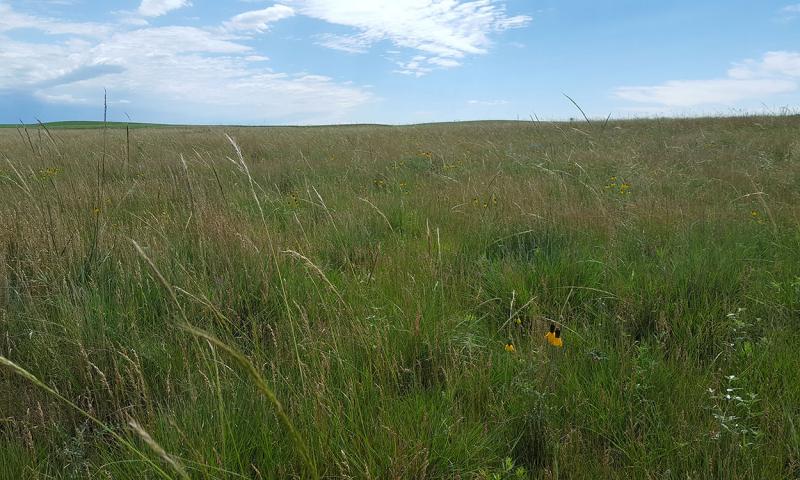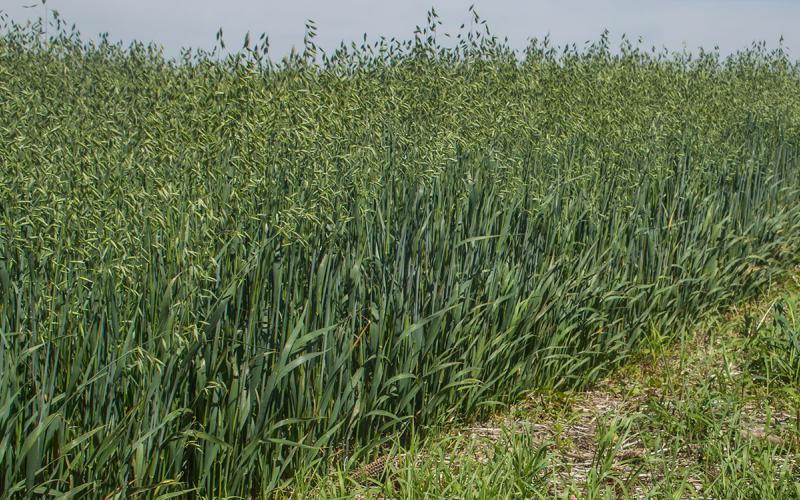
Written collaboratively by Pete Bauman, Karla Hernandez and Sandy Smart.
In the first article in this series, we discussed basic terminology and economics. This article focuses on the ecological impacts of fertilization in various grassland plant communities, including native rangelands and prairies.
Fertilization Impacts to Grasslands
Artificial fertilization (primarily nitrogen) of grasslands is not a new subject. In fact, European researchers have expended possibly more energy on this topic than have their counterparts here in North America, with the oldest grassland fertilization experiment in the world known as the Park Grass Experiment dating back to 1856 in England. There, the original question was regarding application of different manures to a grassland. In recent decades, grassland fertilization has continued to be the source of much study in both Europe and North America. While not a great deal of published studies exist that specifically look at nitrogen impacts on South Dakota’s grasslands, it is important to note that studies conducted elsewhere can shed some light on observations of fertilizer impacts to grasslands here in South Dakota and the region.
Most importantly, it is imperative to understand that not all grasslands are created equally. Variations in soils, precipitation, landscape position and site history can impact how and why the plant community responds to nitrogen. Of these variables, the most critical component for the manager is to understand what type of plant community is being targeted for fertilization and why. While the general-assumed intention of fertilization is increased productivity of the target vegetation, the actual productivity response may not be desirable over time or space. Largely, this depends on whether nitrogen is applied to native pastures, tame pastures or tame hayfields. We will discuss the differences in these plant communities in our case studies.
Productivity
Throughout most of the studies we reviewed on this topic, nitrogen fertilization does generally increase overall grassland productivity. However, if productivity was simply a result of all plants in the community growing ‘bigger,’ then the topic of nitrogen fertilization would not likely be controversial. The real challenge in grassland fertilization is understanding which plants in the community respond to the nitrogen through increased productivity and how that increased productivity impacts the plant community as a whole. In many cases, increased productivity results from very few species of the plant community responding favorably, thus increasing their competitive advantage to the detriment of the community as a whole.
Competitive Response, Native Plant Reduction and Invasive Species
With nitrogen no longer limiting, certain species adept at utilizing nitrogen can now flourish. As the total production of these species increases, they tend to over-compete for other limited resources, such as light, water, crown and root space. Heavy shading through increased biomass and increased plant litter can result, limiting the growth potential of native plants and ultimately…possibly… reducing or eliminating their ability to compete in the plant community. The loss of well-adapted native vegetation through this competition for space can lead to an overall decrease in desirable community. Reduction in native vegetation can lead to lack of plant resiliency during periods of fluctuating resource availability (such as drought). Ultimately, the reduction in native plant resiliency can leave once-filled niches open for invasion by less desirable species, such as invasive cool-season grasses or broad-leaf weeds.
While the addition of nitrogen will still favor undesirable species in a native system, it is worth noting that the potential negative impacts of artificial litter accumulation through increased biomass production can be mitigated through removal mechanisms, such as haying or grazing. However, in systems where annual management may vary due to conservation or habitat objectives, such as Conservation Reserve Program (CRP) grassland projects, nitrogen and the increased litter associated with nitrogen-enhanced production can have a dramatic negative impact on native grass and broadleaf seedling survival. This, in turn, can diminish the plant community, leading to decreased production of desirable pollinator forbs and the insects associated with them, and it can limit the availability of food sources for the target wildlife species, such as pheasants or upland birds, while again increasing the need for additional weed control as a result of invasion of nitrogen-friendly weedy species.
Community Resiliency
To fertilize a typical South Dakota native pasture is to fertilize a plant community that likely already has some level of infestation of introduced or invasive non-native grasses that will respond favorably to nitrogen (smooth bromegrass, Kentucky bluegrass, crested wheatgrass or cheat grass as examples). In a dry year, the applied nitrogen may not be completely available to the invasive grasses, and thus, little production increase may result. In a wet year, the invasive grasses may flourish and may strengthen their overall position in the plant community while outcompeting the native vegetation. This artificial ‘boost’ in productivity may be viewed at first as beneficial, perhaps even profitable. However, over the long term, continuous management under this philosophy may transform the once healthy native pasture to one now dominated by invasive grasses. It also reduces the pasture’s ability to sustain production in drought years when production is naturally limited by environmental conditions other than nitrogen availability. Ultimately, this limits the manager’s ability to vary the season of use of the pasture, because the plant community becomes too uniform, or simple, for multi-seasonal use.
While still requiring a cost-benefit assessment, fertilization of low-diversity, non-native planted hayfields or pastures will likely have less long-term impact on the plant community resiliency, because the community has been pre-selected. Therefore, profit resulting from production boosts from nitrogen fertilization and increased harvest efficiency may be realized.
Resources and References:
- Nutrient Network: Includes links to several articles on the topic.
- Bruckner, Monica. (2012). The Gulf of Mexico Dead Zone. Montana State University.
- Alpert, P., E. Bone, and C. Holzapfel. 2000. Invasiveness, invisibility and the role of environmental stress in the spread of non-native plants. Perspectives in plant ecology, evolution, and systematics. 3:52-66.
- Borer, E.T., E.W. Seabloom, D.S. Gruner, W.S. Harpole, H. Hillebrand4, E.M. Lind1, P.B. Adler, J. Alberti, T.M. Anderson, J.D. Bakker, L. Biederman, D. Blumenthal, C.S. Brown, L.A. Brudvig, Y.M. Buckley, M. Cadotte, C. Chu, E.E. Cleland. M.J. Crawley, P. Daleo, E.I. Damschen, K.F. Davies, N.M. DeCrappeo, G. Du, J. Firn, Y. Hautier, R.W. Heckman, A. Hector, J. HilleRisLambers, O. Iribarne, J.A. Klein, J.M. H. Knops., K.J. La Pierre, A.D.B. Leakey, W. Li, A.S. MacDougall, R.L. McCulley, B.A. Melbourne, C.E. Mitchell, J.L. Moore, B. Mortensen, L.R. O’Halloran, J.L. Orrock, J. Pascual, S.M. Prober, D.A. Pyke, A.C. Risch, M. Schuetz, M.D. Smith, C.J. Stevens, L.L. Sullivan, R.J.Williams, P.D. Wragg, J.P. Wright, and L.H. Yang. 2014. Herbivores and nutrients control grassland plant diversity via light limitation. Nature. 00:1-4.
- Dickson, T.L. and B.L. Foster. 2011. Fertilization decreases plant biodiversity even when light is not limiting. Ecology Letters. 14:380-388.
- Foster, B.L., and K.L. Gross. 1998. Species richness in a successional grassland: effects of nitrogen enrichment and plant litter. Ecology. 79:2593-2602.
- Harpole, W.S., and D. Tilman. 2007. Grassland species loss resulting from reduced niche dimension. Nature. 446:791-793.
- Hautier, Y., P.A. Niklaus, and A. Hector. Competition for light causes plant biodiversity loss after eutrophication. 2009. Science. 324:636-638.
- Hautier, Y., E.W. Seabloom, E.T. Borer, P.B. Adler, W.S. Harpole, H. Hillebrand, E.M. Lind, A.S. MacDougall, C.J. Stevens, J.D. Bakker, Y.M. Buckley, C. Chu, S.L. Collins, P. Daleo, E.I. Damschen, K.F. Davies, P.A. Fay, J. Firn, D.S. Gruner, V.L. Jin, J.A. Klein, J.M.N. Knops, K.J. La Pierre, W. Li, R.L. McCulley, B.A. Melbourne, J.L. Moore, L.R. O’Halloran, S.M. Prober, A.C. Risch, M. Sankaran, M. Schuetz, and A. Hector. 2014. Eutrophication weakens stabilizing effects of diversity in natural grasslands. Nature. 508:521-525.
- Hector, A., Y. Hautier, P. Saner, L. Wacker, R. Bagchi, J. Joshi, M. Scherer-Lorenzen, E. M. Spehn, E. Bazeley-White, M. Weilenmann, M. C. Caldeira, P. G. Dimitrakopoulos, J. A. Finn, K. Huss-Danell, A. Jumpponen, C. P. H. Mulder, C. Palmborg, J. S. Pereira, A. S. D. Siamantziouras, A. C. Terry, A. Y. Troumbis, B. Schmid, and M. Loreau. 2010. General stabilizing effects of plant diversity on grassland productivity through population asynchrony and overyielding. Ecology. 91:2213-2220.
- Lamb, E.G. 2008. Direct and indirect control of grassland community structure by litter, resources, and biomass. Ecology. 89:216-225.
- Seabloom, E.W, C.D. Benfield, E.T. Borer, A.G. Stanley, T.N. Kaye, P.W. Dunwiddie. 2011. Provenance, life span, and phylogeny do not affect grass species' responses to nitrogen and phosphorus. Ecological Applications. 21:2129-2142.
- Silvertown, J.P, P. Poulton, E. Johnston, G. Edwards, M. Heard, and P.M. Bliss. 2006. The Park Grass Experiment 1856-2006: Its contribution to ecology. Journal of Ecology. 94:801-814.
- Stevens, C.J., N.B. Dise, J.O. Mountford, and D.J. Gowing. 2004. Impact of nitrogen deposition on the species richness of grasslands. Science. 303:1876-1879.


